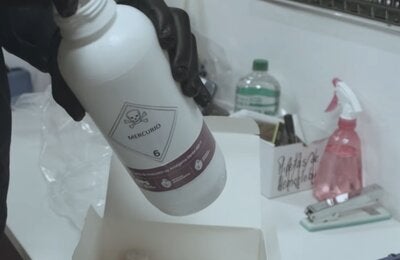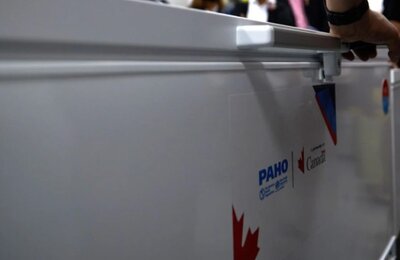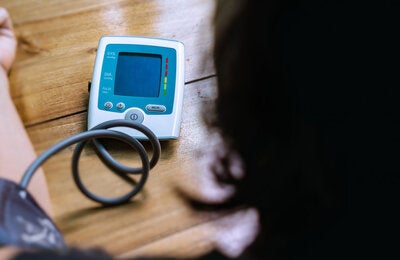
Public health experts, humanitarian clowns, members of the Belén Network come together to help the inhabitants of Belén, Iquitos, Peru.
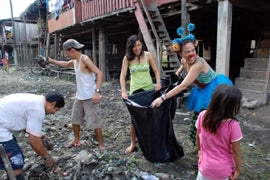
Photos Sonia Mey, PAHO/WHO
Washington, D.C., 4 August 2010 (PAHO) — For the fifth consecutive year, art is being used as a bridge to promote health during the Belén Festival held from 4 to 14 August in Belén, Iquitos, Peru in conjunction with the Gesundheit! Institute and Bolaroja, headed respectively by Dr. Patch Adams and Wendy Ramos.
Free workshops on paper puppets and percussion instruments will be held to benefit members of the Belén community, along with large fairs with traditional games and public health and environmental activities aimed at promoting health, nutrition, the environment, and food safety in the home and markets to keep them clean and healthy.
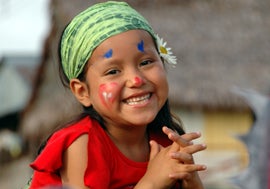 The Belén Festival is being held nearly a year after the Pan American Health Organization/ World Health Organization (PAHO/WHO) and the Red Latinoamericana de Arte para la Transformación Social (RLATS), or Latin American Network of Art for Social Transformation, signed a framework agreement on promoting art as a bridge between health and development. Festival activities are being organized by the Belén Network, comprised of the Gesundheit! Institute; Bolaroja; nongovernmental organizations, such as La Restinga and Selva Amazónica; local and regional governments; PAHO; and others. Support is also being provided by the Peruvian Navy and Air Force and the Stella Maris Association.
The Belén Festival is being held nearly a year after the Pan American Health Organization/ World Health Organization (PAHO/WHO) and the Red Latinoamericana de Arte para la Transformación Social (RLATS), or Latin American Network of Art for Social Transformation, signed a framework agreement on promoting art as a bridge between health and development. Festival activities are being organized by the Belén Network, comprised of the Gesundheit! Institute; Bolaroja; nongovernmental organizations, such as La Restinga and Selva Amazónica; local and regional governments; PAHO; and others. Support is also being provided by the Peruvian Navy and Air Force and the Stella Maris Association.
As in past years, many of the 15,000 residents of the Pueblo Libre community in Belén are awaiting the arrival of dozens of humanitarian clowns from all over the world. In addition to bringing love and happiness and holding workshops, they will work with homeowners to paint their houses, thanks to the support and donation of more than 300 gallons of paint from the CPP (Peruvian Paint Company) and the Chems company.
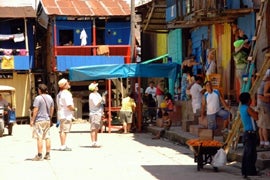 Painting houses is a way of directly connecting with families. It is a bridge that creates a direct link between the community and public health, making it possible to become involved in the situation of Belén, a community that suffers from serious malnutrition, basic sanitation problems, social violence, a wide range of diseases, and other issues.
Painting houses is a way of directly connecting with families. It is a bridge that creates a direct link between the community and public health, making it possible to become involved in the situation of Belén, a community that suffers from serious malnutrition, basic sanitation problems, social violence, a wide range of diseases, and other issues.
Members of the Belén Network, under the "Faces, Voices and Places" initiative of the Millennium Development Goals, have been working together throughout the year to improve the quality of life of this population through an intersectoral project that is sustainable over time, with an emphasis on empowering the population to take control of their destiny and development.
Activities at this extensive Belén Festival will include the participation of La Restinga, Selva Amazónica, La Canoita, health networks and micronetworks, UGEL, MIMDES-Wawa Wasi, DEMUNAS, URBAL, GOREL, PROYÑOS, ACSA, the Ministry of Health of Peru, the Peruvian Navy, the Peruvian Army, the District City Hall of Belén, local and regional governments, the Regional Health Office (DIRESA), MDB, DESA, Clas Belén, Amazon Promise, Airline Ambassadors, Doctors for Orphans, Civil Defense, Construyendo Perú, INFANT, the Belén police station, CPP (Peruvian Paint Company), Chems, Tay Loi, Vaso de Leche, churches, community delegates, neighborhood groups from Pueblo Libre, and grassroots organizations like public cafeterias.
Links:
Videos:
Photo Montage:
Others:

